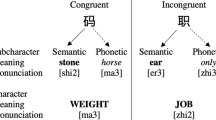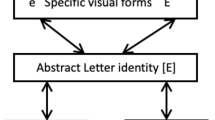Abstract
From the perspective of the strategy-based judgment, the present paper researched the process by which the reading of a Chinese character (kanji) is identified as On (reading borrowed from Chinese) or Kun (native Japanese reading). In these experiments, questionnaires containing a list of Chinese characters and their associated readings were printed, and subjects were asked to judge whether the reading given was On or Kun. Subjects were also asked to state the degree of confidence they felt in making this judgment. In Experiment 1, the survey consisted of characters which have only an On-reading. The correct rate and degreeof-confidence judgments from this test suggest that in deciding whether a reading is On or Kun, the strategy employed is ‘If the reading for a character which occurs independently has concrete meaning, it is a Kun-reading; if the reading does not have concrete meaning, it is an On-reading’. In Experiment 2, the questionnaire was made up of characters with multiple readings, both On and Kun. From the results of this latter experiment, it would appear that the strategy employed when a character has multiple readings is to reserve judgment regarding the On- or Kun-reading until after the various possible readings have been compared with one another. In addition, the results of these experiments suggest that the strategy employed differs depending on the number of readings that can be assigned to each character. When only one reading is possible, subjects make a judgment directly, but when multiple readings exist for a given character the subjects first compare the possible readings and make inferences; only when this process is complete do they apply a strategy to identify a reading as On or Kun.
Access this chapter
Tax calculation will be finalised at checkout
Purchases are for personal use only
Preview
Unable to display preview. Download preview PDF.
Similar content being viewed by others
References
Kitao, N., Hatta, T., Ishida, M., Babazono, Y. and Kondo, Y. (1977). Kyoiku kanji 881 ji no gutaisei, shokeisei oyobi jukuchisei [Concreteness, hieroglyphicity and familiarity of kanji], Shinrigaku Kenkyu [The Japanese Journal of Psychology] 48: 105–111.
Kokuritsu Kokugo Kenkyujo [The national language research institute] (1976). Gendai shinbun no kanji [A study of uses of Chinese characters in modern newspapers]. Tokyo: Shuei Shuppan.
Nomura, Y. (1978). Kanji no joho shori: ondoku kundoku to imi no fuyo [The information processing of Chinese characters (kanji): Chinese reading, Japanese reading and the attachment of meaning], Shinrigaku Kenkyu [The Japanese Journal of Psychology] 49: 190–197.
Nomura, Y. (1979). Kanji no joho shori: ondoku kundoku no kensaku katei [Information processing of Chinese characters (kanji): Retrieval processes in Chinese-style reading (On), and Japanese-style reading (Kun)], Shinrigaku Kenkyu [The Japanese Journal of Psychology] 50: 101–105.
Saito, H. (1978). Kanji no joho shori ni tsuite (1): Tokuni sono onin shori to keitai shori no kankei [Human information processing of kanji (Chinese characters): The close relationship between auditory and visual aspects], Jinbun Ronkyu [The Journal of the Literary Association of Kwansei Gakuin University] 28: 95–111.
Wydell, T. N., Butterworth, B. and Patterson, K. (1995) The inconsistency of consistency effects in reading: The case of Japanese Kanji, Journal of Experimental Psychology: Learning, Memory, and Cognition 21: 1155–1168.
Author information
Authors and Affiliations
Corresponding author
Editor information
Editors and Affiliations
Rights and permissions
Copyright information
© 1998 Springer Science+Business Media Dordrecht
About this chapter
Cite this chapter
Hirose, H. (1998). Identifying the On- and Kun-readings of Chinese characters: Identification of On versus Kun as a strategy-based judgment. In: Leong, C.K., Tamaoka, K. (eds) Cognitive Processing of the Chinese and the Japanese Languages. Neuropsychology and Cognition, vol 14. Springer, Dordrecht. https://doi.org/10.1007/978-94-015-9161-4_11
Download citation
DOI: https://doi.org/10.1007/978-94-015-9161-4_11
Publisher Name: Springer, Dordrecht
Print ISBN: 978-90-481-5140-0
Online ISBN: 978-94-015-9161-4
eBook Packages: Springer Book Archive




